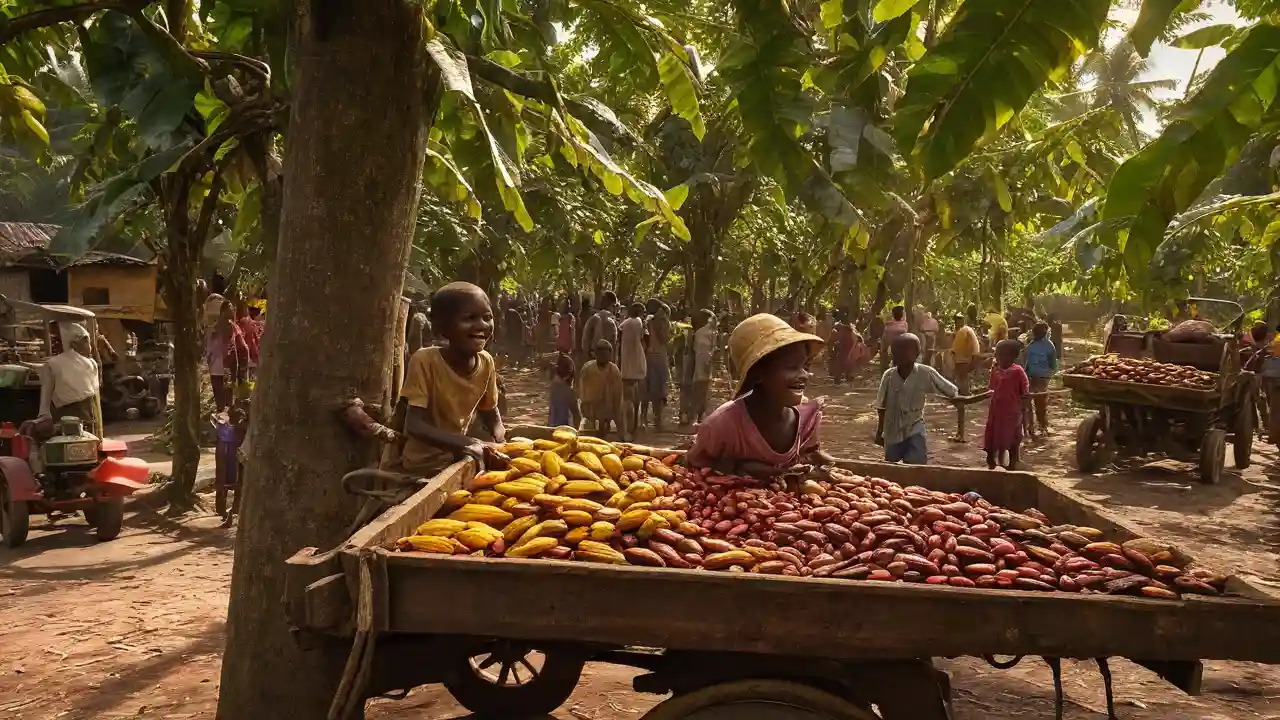
Cocoa’s Big Slide: Chocolate’s Price Crash Signals a Market in Flux
Cocoa’s Big Slide: Chocolate’s Price Crash Signals a Market in Flux
Eight straight weeks of falling prices mark the steepest cocoa downturn in more than two decades, as weak demand collides with growing supply optimism.
NEW YORK — Cocoa prices are tumbling after a year that left chocolate lovers and candy makers reeling. Futures in New York have fallen for eight weeks in a row—the longest losing streak since 1999. Just months ago, the same contracts soared past $12,000 a ton, smashing records and sparking fears of permanent sticker shock in chocolate aisles. Now the rally has collapsed, and traders are coming to terms with a very different market.
The most active contract slipped 1% Friday to $5,888 per ton, leaving prices down 4% for the week. That’s roughly half of this year’s peak, though still far higher than the levels seen before 2023. What’s driving the plunge? A messy mix of soft demand, shifting supply forecasts, and traders pulling back after a speculative frenzy.
The Problem With Sky-High Prices
Cocoa’s troubles stem from a classic commodity dilemma: when prices soar too high, they kill the very demand that supported them. Earlier this year, the surge forced chocolate makers to rethink recipes, shrink product sizes, and even cut seasonal offerings.
The effect was brutal. Data from the second quarter showed cocoa grinding—essentially the raw measure of chocolate demand—fell sharply around the world. Europe saw a 7.2% drop from a year earlier, North America slipped 2.8%, and Asia plunged 16.3%.
As one market analyst put it, “The industry rewired itself around using less cocoa. That doesn’t flip back overnight just because prices cool.”
All eyes now turn to next week, when Europe’s Cocoa Association will publish its third-quarter data. If demand keeps shrinking, bearish bets could pile on. But any hint of stabilization may force traders who went short to cover their positions quickly.
From Scarcity to Surplus
The other side of the story is supply. Not long ago, the market faced a record deficit of nearly half a million tons. Stocks hit multi-decade lows, and prices exploded. But weather has improved, and farmers in top producers Côte d’Ivoire and Ghana are delivering more beans after governments raised farm-gate prices.
Ivory Coast boosted its guaranteed price to CFA 2,800 per kilo, while Ghana lifted its level to GHS 58,000 per ton. Those moves helped farmers offset high costs and fight crop disease.
Even a modest surplus in the next harvest season could flip the script. Instead of flooding the market, any extra beans would first rebuild inventories, which remain lean by historic standards. Thin stocks mean volatility is here to stay: prices can swing wildly on the back of weather, logistics, or politics.
Hedge Funds Change Sides
Speculators, who once drove cocoa to dizzying heights, have now turned bearish. Hedge funds hold net short positions for the first time in three years, according to regulators. Their shift has accelerated the price drop.
Liquidity has also dried up. With fewer players in the market, even modest trades can spark large swings. This fragile setup leaves cocoa exposed to sudden squeezes: if supply hiccups or demand rebounds, prices could spike before traders can react.
Who Wins, Who Loses
Cheaper cocoa is a double-edged sword. Chocolate makers gain breathing room on costs, but the demand they lost through reformulation and consumer sticker shock won’t bounce back quickly. Shoppers also shouldn’t expect instant relief. Retail prices tend to fall much more slowly than futures do.
For farmers, the picture is complicated. Yes, higher farm-gate prices support incomes. But if global futures keep falling while input costs stay high, margins shrink. On top of that, threats like swollen shoot virus continue to haunt production, raising the risk of long-term underinvestment.
Traders, meanwhile, face a market that’s both thin and jumpy. Weather setbacks, crop disease, or policy changes in producing countries could easily trigger sharp rallies against the prevailing bearish tide.
What Could Happen Next
Market watchers outline three likely scenarios for cocoa through mid-2026:
- Base case: Grinding volumes stabilize at lower levels, and the 2025-26 season brings a modest surplus. Prices hover between $4,800 and $6,800 per ton, with rallies capped unless shocks hit supply.
- Bullish case: Bad weather or disease cuts output in West Africa. Speculators scramble to cover shorts, sending prices racing above $7,500.
- Bearish case: Demand keeps weakening and supply beats expectations. Futures could slide to $4,000–$4,500 by late 2026. Shoppers, though, wouldn’t see much relief at the checkout right away.
Strategic Takeaways
For chocolate companies, the safest bet is to stick with products that use less cocoa while slowly testing consumer appetite with promotions. Procurement managers might hedge in layers to balance risk, though they’ll need to watch for sudden squeezes.
Traders are eyeing options structures that limit losses but keep exposure to surprise rallies. And some manufacturers are looking to source more beans from Latin America to reduce dependence on West Africa.
Still, the long-term health of the market rests heavily on whether farmers in Côte d’Ivoire and Ghana can keep investing in disease control and productivity. Without that, today’s surplus could quickly swing back to tomorrow’s shortage.
Cocoa’s eight-week slump isn’t just a correction—it marks a turning point. The wild rally that once symbolized scarcity is giving way to a more balanced, if still precarious, market. Whether prices settle into a new normal or swing back into chaos depends on the weather, next week’s demand data, and how fast the industry adapts to a world where chocolate can’t always count on cheap cocoa.